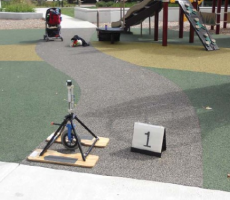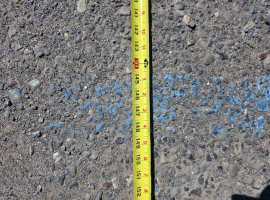We know that 303.2 and 303.3 limit intentional vertical changes in elevation to 1/4" or 1/4" depending on the surface shape. Your picture seems to show gaps between level aggregate, as well as loose stones and fines - - but for the sake of this discussion I will assume the issue is not vertical elevation change.
Given that 302.2 allows carpets and 302.3 allows holes (grates) of 1/2" or less, the main issue appears to be an interpretation as to what constitutes a stable, firm and slip resistant surface. We also see carpet, decomposed granite and some artificial turf as unpaved surfaces that claim to comply.
I believe that the standard is ultimately performance-based, with little objective criteria given.
In 1999, the US Architectural and Transportation Barriers Compliance Board published a pilot study that has been referenced often in courts and other jurisdictions. They use ASTM F1951 (now
ASTM 1951-21) as the test method, and it involves a rotational penetrometer to see how wheels turn on the surface:

Here's a link to the study:
https://www.access-board.gov/files/research/exterior-surfaces.pdf
See also:
https://www.access-board.gov/aba/guides/chapter-10-play-surfaces/
So to respond to your original question: You might not be able to make a formal determination without a penetrometer test. Even after doing the test, if there were ever a lawsuit, it would be a pi$$ing contest between expert witnesses, though it is likely that if it passed the penetrometer test you would have a strong case.
My recommendation is if you believe the intent was to have a firm asphalt surface, thoroughly clean (compressed air or water blast) the surface to remove all loose fines. Check for gaps and obvious vertical changes. If it looks questionably unstable and you are advising the owner, and they really want to have a compliant surface, they should either (a) get a penetrometer test, or better yet (b) just spend the money to grind and overlay a new smooth surface instead.
These days, most of my clients are opting to (c) tear it out and replace it with concrete for durability and slope control.



